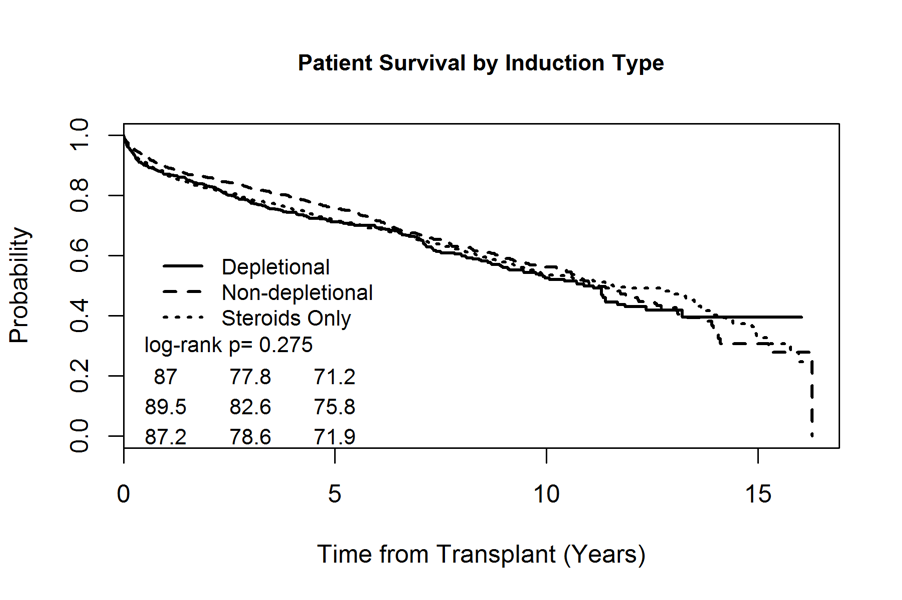Type of Induction Does Not Impact Patient or Kidney Allograft Survival in Simultaneous Liver and Kidney Transplant Recipients in the United States
1University of Minnesota, Minneapolis, MN, 2Medicine, University of Minnesota, Minneapolis, MN, 3Complex Care Analytics, Fairview Health Services, Minneapolis, MN
Meeting: 2019 American Transplant Congress
Abstract number: B205
Keywords: Graft survival, Induction therapy, Kidney/liver transplantation, Outcome
Session Information
Session Name: Poster Session B: Kidney Immunosuppression: Induction Therapy
Session Type: Poster Session
Date: Sunday, June 2, 2019
Session Time: 6:00pm-7:00pm
 Presentation Time: 6:00pm-7:00pm
Presentation Time: 6:00pm-7:00pm
Location: Hall C & D
*Purpose: Induction practices vary widely in the United States for patients undergoing simultaneous liver and kidney (SLK) transplantation. We examined the impact of induction type on patient and kidney allograft survival utilizing the Scientific Registry of Transplant Recipients (SRTR) database.
*Methods: We examined adult primary SLK transplants from October 2001 to December 2015. Patients were grouped according to type of induction regimen used: cyto-depletional agents, non-depletional agents and steroids only. Patients who received both depletional and non-depletional induction regimens, or non-standard regimens, were excluded. Kaplan-Meier survival curves and Cox proportional hazards models (with transplant center as a random effect and censored at 1 year) were used to ascertain the impact of induction on patient survival and death-censored kidney allograft survival. Kaplan-Meier estimates at 1,3 and 5 years are also shown in each figure.
*Results: 3388 patients received primary SLK transplants over the study period. Kaplan-Meier curves showed no differences in patient survival (fig. 1) or death-censored kidney graft survival (fig. 2) with regard to type of induction regimen used. Multivariate Cox proportional hazards model for patient survival at one year showed no effect for type of induction regimen used. Donor age, donor height, recipient mismatch status and recipient ICU status at time of transplant were predictive of patient survival at 1 year. Non-depletional induction (vs. depletional) was associated with a 39% decrease in the risk of death-censored graft loss (HR 0.61, 95% CI 0.39-0.97, p 0.037). Recipient BMI, dialysis status, ICU status at transplant, donor age, sex and height were also predictive of kidney graft loss at 1-year.
*Conclusions: Type of induction did not influence patient survival in SLK transplant recipients. Non-depletional induction decreased the risk of death-censored kidney graft loss. Non-depletional induction regimens should be preferred in SLK recipients given the higher cost and increased risk of infection associated with depletional regimens.
To cite this abstract in AMA style:
Riad S, Lim N, Jackson S, Lake J. Type of Induction Does Not Impact Patient or Kidney Allograft Survival in Simultaneous Liver and Kidney Transplant Recipients in the United States [abstract]. Am J Transplant. 2019; 19 (suppl 3). https://atcmeetingabstracts.com/abstract/type-of-induction-does-not-impact-patient-or-kidney-allograft-survival-in-simultaneous-liver-and-kidney-transplant-recipients-in-the-united-states/. Accessed December 21, 2025.« Back to 2019 American Transplant Congress


